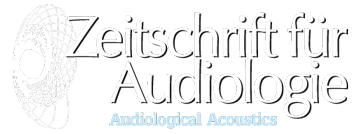Questionnaires as screening tools to identify persons with hearing deficiencies
Fragebögen als Screening-Verfahren zur Identifikation von Personen mit Hörstörungen
Roland Jacob, Yvonne Stelzig, Michael Buschermöhle, Daniel Berg, Markus Meis
Abstract: The aim of the study was the development and the selection of an easy to use questionnaire for the screening of hearing deficiencies in the realm of an automated screening station and in epidemiological studies. Two questionnaire tools were compared using a postal survey: The Hearing-Dependent Daily Activities (HDDA) Scale with values between 0-24 points and the HearCom Questionnaire (HCQ), ranging from 0 to 1.0. From N = 873 questionnaires sent out, 443 data sets were used. For these participants, current and resilient audiogram data were available. The mean age was M = 66.5 years (52.6 % male) and 37.9 % of the participants were using hearing aids. The mean pure tone average (PTA) on the better ear was 26.5 dB HL (averaged for 0.5, 1.0, 2.0 und 4.0 kHz). This corresponds approximately to the WHO threshold of hearing impairment. The sum score of the HDDA showed higher correlation with the PTA in comparison to the HCQ. For the HDDA, a sensitivity of 90.6 % and a specificity of 80.1 % were determined. According to Receiver Operating Characteristic (ROC) curves for the worse ear (≥ 26 dB HL), a cut-off score of ≥ 19 was the most suitable one. For the HCQ, a cut-off value of 0.74 was determined with sensitivity and specificity of 74.6 % and 85.5 %, respectively. Due to the better sensitivity and ROC characteristics, a lower number of items and a lower rate of missing data, we suggest using the HDDA with a conservative cut-off criterion of ≥ 19 as an appropriate screening tool in Germany for the assessment of hearing deficiencies.
Keywords: Hearing impairment, adult hearing screening, questionnaire, HDDA, sensitivity, specificity
List of abbreviations:
BEA: Better ear average
HDDA: Hearing-Dependent Daily Activities Scale
HCQ: HearCom Questionnaire
HearCom: EU Project “Hearing in the communication society”
HL: hearing loss
PTA: Pure tone average
ROC: Receiver-Operating-Characteristic
SD: Standard deviation
WEA: Worse ear average
Zusammenfassung: Ziel der Studie war die Entwicklung und Auswahl eines ökonomisch zu handhabenden Fragebogens zur Ermittlung von Hörstörungen im Rahmen einer automatisierten Messstation und epidemiologischer Studien. Es wurden zwei Fragebogenverfahren als Screening-Instrumente im Rahmen einer postalischen Studie miteinander verglichen: Die Hearing-Dependent Daily Activities (HDDA) Skala mit Werten zwischen 0-24 Punkten und der HearCom-Fragebogen (HCQ) mit einer Skala von 0 bis 1.0. Von N = 873 versendeten Fragebögen konnten insgesamt N = 443 Datensätze verwendet werden, bei denen aktuelle tonaudiometrische Daten vorlagen. Das mittlere Alter betrug M = 66,5 Jahre (52,6 % männlich) und 37,9 % der Teilnehmer waren Hörgeräteträger. Im Mittel hatten die Probanden auf dem besseren Ohr einen Hörverlust von 26,5 dB HL gemittelt über die Frequenzen 0,5, 1,0, 2,0 und 4,0 kHz, was in etwa der tonaudiometrischen Schwelle der WHO Definition hörbeeinträchtigt vs. nicht hörbeeinträchtigt entspricht. Der HDDA zeigte durchweg höhere Korrelationen zum PTA als der HCQ-Fragebogen. Für den HDDA konnte eine Sensitivität von 90,6 % und eine Spezifität von 80,1 % bei einem Cut-off von ≥ 19 auf Basis von Receiver Operating Characteristic (ROC) Kurven ermittelt werden, wenn das jeweils schlechtere Ohr (≥ 26 dB HL) berücksichtigt wurde. Für den HCQ Fragebogen wurde ein Cut-off Wert von 0.74 für das schlechtere Ohr bestimmt, mit einer Sensitivität von 74,6 % und einer Spezifität von 85,5 %. Aufgrund der besseren Sensitivität und ROC Charakteristik, des geringeren Umfanges und der geringeren Rate fehlender Werte wird der HDDA bei einem konservativem Cut-off Wert von ≥ 19 als geeigneter deutschsprachiger Fragebogen zur Ermittlung von Hörstörungen als Screening-Instrument empfohlen.
Schlüsselwörter: Hörbeeinträchtigung, Hörscreening für Erwachsene, Fragebogen, HDDA, Sensitivität, Spezifität
